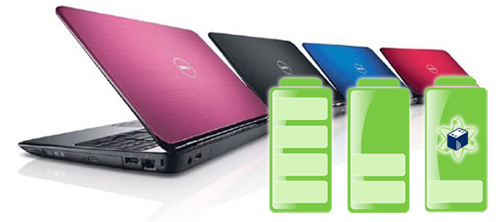What is the best way to store lithium ion batteries ?
Some of us use laptops as desktop alternatives, so it doesn’t make much sense to put batteries in notebook computers. This eventually reduces its energy storage capacity. This is the best way to store it.
Storing a Lithium-Ion Battery
But will my laptop work without the battery while it’s plugged in?
The answer is yes, while plugged into AC, your laptop will work just fine even if the battery isn’t inside it, as detailed in this article. Now that we’ve got that out of the way, let’s see what the best way to store a laptop battery is.
Today, Lithium-Ion batteries are the battery type found in pretty much 99% of all laptop PC and devices sold over that past five years. Now although most Lithium-Ion batteries will perform well for 2-3 years, if you want to extend the life of your Dell inspiron 1520 laptop battery, you can following a few tips.
First, before storing your battery, make sure it’s not empty. Over time, batteries will leak power so if it’s stored at no charge in it, there’s a chance it won’t accept a charge again. Since this defeats our goal of extending the life of a battery… don’t do that!
In order to lose the smallest amount of power while in storage, change your battery to 40% then unplug it and store it in a temperature controlled location. The below graph outlines the ideal charge point and temperature for battery storage.
| Storage Temperature | Charged to 40% – capacity loss after a year | Charged to 100% – capacity loss after a year |
| 0 °C (32 °F) | 2% | 6% |
| 25 °C (77 °F) | 4% | 20% |
| 40 °C (104 °F) | 15% | 35% |
| 60 °C (140 °F) | 25% | 40% |
As you can see, 0 degrees centigrade (which translates to 32 degrees Fahrenheit) and 40% battery charge loses the least amount of power. Just 2%. The reason is that constant temperature is your best friend. Now the good news is most refrigerators hover between 34-38 degrees Fahrenheit which is almost perfect. It also provides the battery a constant temperature that rarely changes.
Charge my battery to 40% then stick it in the fridge. Got it. Anything else?
The problem with a refrigerator is that it’s a damp environment, which could cause parts of the battery to rust. So, before you put the battery in the refrigerator, make sure you put it in a Ziploc bag. If you want to take extra precautions, I also suggest putting a desiccant in the Ziploc bag, along with the battery. Getting one shouldn’t be too difficult – almost anything you buy these days will be packed with one.
It’s also a good idea to remove the battery from your fridge every month and perform a full recharge-discharge cycle before putting it back in. Before you put it back in the laptop, though, make sure that you let the Ziploc bag containing it reaches room temperature. If you don’t, there’s a serious risk of damaging the battery. If you follow the instructions above, your Lithium-Ion battery will be in great shape next time you need it.
Did you enjoy this post? Why not leave a comment below and continue the conversation, or subscribe to my feed and get articles like this delivered automatically to your feed reader.


Comments
No comments yet.
Sorry, the comment form is closed at this time.